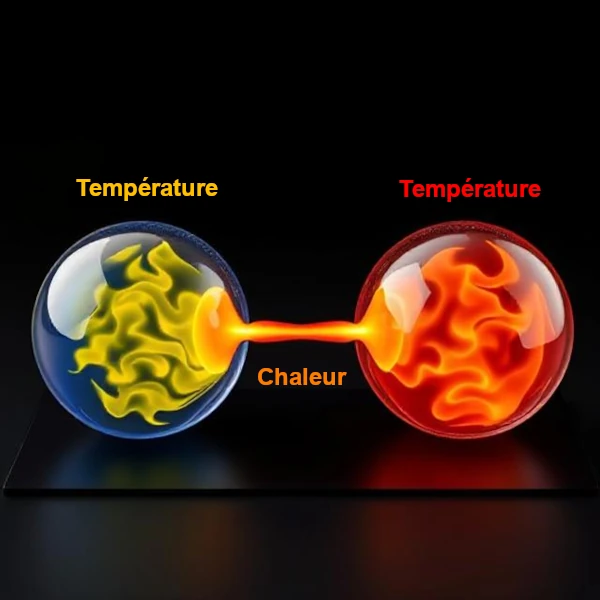
In physics, heat and temperature are two related but fundamentally different concepts.
Temperature is a physical measure that indicates the degree of heat or cold of an object, substance, or environment. It is directly related to the average kinetic energy of microscopic particles (atoms or molecules) that make up matter: the faster the particles move, the higher the temperature.
Temperature is an intensive quantity: it does not depend on the size of the system (mass, volume, amount of matter), it remains constant if the system is divided into several identical parts. It is expressed in kelvins (K) in the International System.
For example, in an ideal gas, the average kinetic energy of a molecule is proportional to \(\frac{3}{2}kT\), where \(k\) is the Boltzmann constant and \(T\) is the temperature. For an ambient temperature of \(T = 300\,\text{K}\), this energy is: \[ \frac{3}{2}kT = \frac{3}{2} \times 1.38 \times 10^{-23}\,\text{J·K}^{-1} \times 300\,\text{K} \approx 6.21 \times 10^{-21}\,\text{J} \] This is an extremely low energy on a macroscopic scale, but sufficient to explain the constant agitation of molecules at room temperature.
Heat is a form of energy in transit between two thermodynamic systems. It does not denote an intrinsic property of a body, but a quantity of energy transferred due to a temperature difference. This transfer can occur through conduction, convection, or radiation, and stops when thermal equilibrium is reached. Heat is therefore a quantity related to an interaction, not the state of an isolated system.
Unlike temperature, heat is an extensive quantity (it depends on mass and material). It is expressed in joules (J) and can only exist during an exchange. It can be transferred by conduction (direct contacts), convection (fluid movements), or radiation (electromagnetic waves).
Specific heat represents the amount of energy required to raise the temperature of 1 kg of material by 1 kelvin (or 1 degree Celsius). For specific heat, the difference between kelvin and degree Celsius is negligible, as we consider a temperature variation, not an absolute temperature.
The higher the specific heat of a material, the more energy is needed to heat a given mass of said material.
| Material | Formula | State | Specific heat \(c\) (J·kg⁻¹·K⁻¹) |
|---|---|---|---|
| Hydrogen | H₂ | Gas | \(14300\) |
| Water | H₂O | Liquid | \(4186\) |
| Ice | H₂O | Solid | \(2090\) |
| Aluminum | Al | Solid | \(900\) |
| Iron | Fe | Solid | \(449\) |
| Copper | Cu | Solid | \(385\) |
| Gold | Au | Solid | \(129\) |
Reference: Handbook of Chemistry and Physics, CRC Press (2024).
The amount of heat required to change the temperature of a material depends on its specific heat \(\,c\,\) (in J·kg⁻¹·K⁻¹): \[ Q = m \cdot c \cdot \Delta T \] where \(Q\) is the heat received, \(m\) is the mass of the body, \(c\) is the specific heat, and \(\Delta T\) is the temperature change.
| Concept | Nature | SI Unit | Quantity | Measurement |
|---|---|---|---|---|
| Temperature | Thermal state | Kelvin (K) | Intensive | Thermometer |
| Heat | Energy in transit | Joule (J) | Extensive | Calorimeter |
It is often said that an object "contains heat," whereas in physical terms, heat is not contained: it is exchanged between systems. What characterizes the thermal state of a body is its temperature, while the internal energy depends on its mass, temperature, and nature. For example, a bucket of lukewarm water can have a greater total internal energy than a red-hot nail, even though its temperature is much lower.
| Example | Temperature | Mass / Volume | Heat transferred |
|---|---|---|---|
| Red-hot nail vs. bucket of lukewarm water | Nail very hot (≈800 °C), water lukewarm (≈40 °C) | Nail: very low Water: large | Greater total thermal energy in water |
| Two air balloons at the same temperature | Identical (same \( T \)) | Small balloon vs. large balloon | The large balloon transfers more heat |
| Two tanks at different pressures | Small tank: very high pressure Large tank: moderate pressure | Small volume vs. large volume | Greater transfer from the large tank |